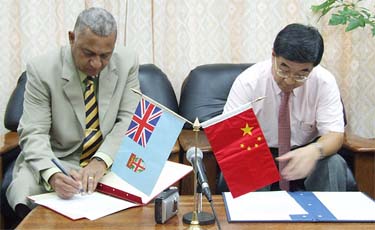One in every seven dollars of national income is spent on oil — in a country where one-third of households live below the poverty line.
The comparative impact of high oil prices in Australia has been minimal. This is due to Australia’s low oil intensity of GDP, which measures 0.08 — meaning 0.08 tonnes of oil is consumed for every US$1000 of GDP. Oil intensity of GDP is higher in China and India, measuring 0.23 and 0.20, respectively. But these figures are still considerably lower than in Fiji, where the oil intensity of GDP is 0.31.
All oil in Fiji and other Pacific island countries is imported. This exposes Pacific island economies to oil price increases, which affect the terms of trade and balance of payments, and lead to inflation and reductions in real household income. As a result, the Asian Development Bank in 2009 estimated that Pacific island economies were among the most vulnerable in the Asia Pacific to oil price volatility; of the 10 most vulnerable economies in the Asia Pacific, seven were Pacific island countries.
High oil prices raise the cost of electricity and ‘staple’ fuels such as kerosene, thus compromising access to energy. Power costs rise because of a reliance on diesel and oil-based generators, which produce the majority of power in all Pacific island countries with the exception of Papua New Guinea and Fiji. These two countries are able to generate significant amounts of power from renewable technologies. High oil prices also affect the national budget in countries where cost increases are absorbed by state-owned utilities. In the extreme case of the Marshall Islands in 2008, for example, this had major fiscal, economic and social impacts, forcing the government to declare a state of national emergency and requiring a major bailout of the electric utility.
Investments in renewable energy technologies are widely advocated among SIDS in the Pacific and elsewhere as a response to high oil prices. But there has, until now, been no analysis of the risk-mitigation benefits of renewable technologies for SIDS. Many cost-benefit analyses in the electricity sector do not consider financial risk — a significant oversight in the Pacific, considering the widely cited ‘risk-mitigation’ or ‘energy-security’ benefits of renewable technologies.
A recently released discussion paper, Renewable Technologies and Risk Mitigation in Small Island Developing States: Fiji’s Electricity Sector, addresses this gap in knowledge by incorporating financial risk into the economic assessment of electricity sector investments. This provides a measure of both the cost and risk-mitigation impact of investments in renewable technologies in Fiji. These impacts are considered from a system-wide perspective, addressing issues of intermittent power supply from renewable technologies. For example, wind turbines do not produce electricity when there is no wind, and so back-up capacity is needed to prevent shortfalls in power supply.
The analysis shows that there are significant cost-reduction and risk-mitigation benefits associated with investments in renewable technologies in Fiji. Investments that have lower expected average costs generally also have lower cost risks — and these benefits tend to increase in accordance with the extent of renewable energy in the overall portfolio.
But not all investments are equal. The most beneficial investments from a risk/cost perspective are those in low-cost renewable technologies, including geothermal, energy efficient, biomass and bagasse technologies. High-cost renewable technologies such as wind and solar power reduce financial risk but increase generation costs. And investment in hydropower, the Fijian government’s flagship renewable energy program, decreases financial risk but has a minimal impact on generation costs.
The analysis suggests that further investment in low-cost, low-risk renewable technologies in Fiji should be encouraged on energy security grounds and with the goal of lowering generation costs in the electricity grid. Such investments should be prioritised over investment in hydropower generation capacity, according to the study, meaning that the Fijian government’s focus on hydropower projects is mistaken when considered from a system-wide perspective.
More broadly, it is imperative to consider financial risk as well as generation costs when planning investments in electricity generation capacity in Pacific island countries and SIDS. Oil-based power generation currently dominates the electricity sector in the majority of these countries. As a result, this sector is vulnerable to oil price increases and oil price volatility, both of which are predicted in the coming decades by the International Energy Agency. Renewable technologies can reduce financial risk in Fiji and other SIDS where oil-based power generation plays a big role in power supply. These technologies should therefore remain a focus for future development projects in the region.
Matthew Dornan is Postdoctoral Research Fellow at the Development Policy Centre, Crawford School of Economics and Government, the Australian National University.
Frank Jotzo is Senior Lecturer at the Crawford School of Economics and Government, and is Director at the Centre for Climate Economics and Policy, the Australian National University.
Matthew Dornan and Frank Jotzo recently published a discussion paper, Renewable Technologies and Risk Mitigation in Small Island Developing States (SIDS): Fiji’s Electricity Sector, at the Crawford School of Economics and Government, the Australian National University.

